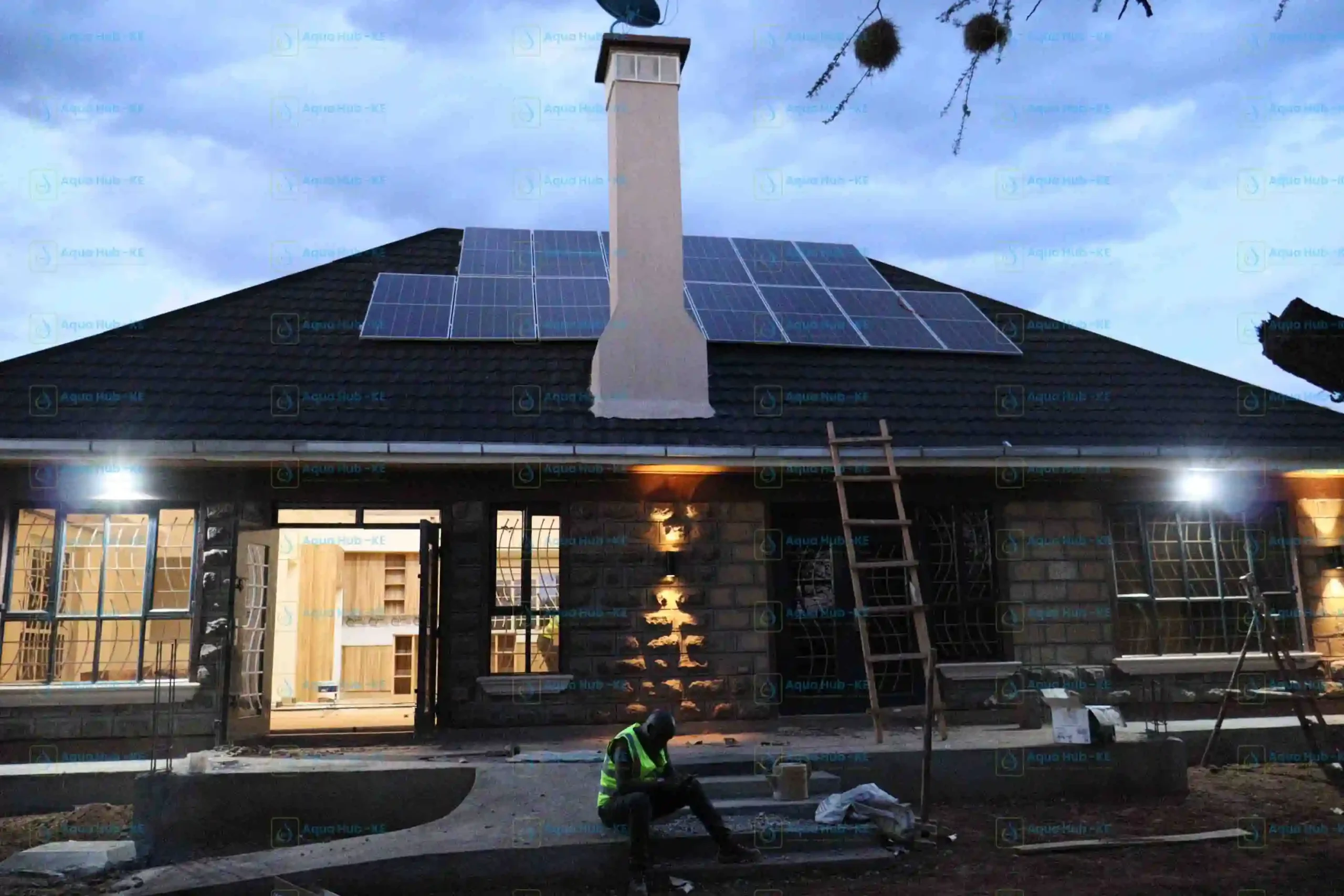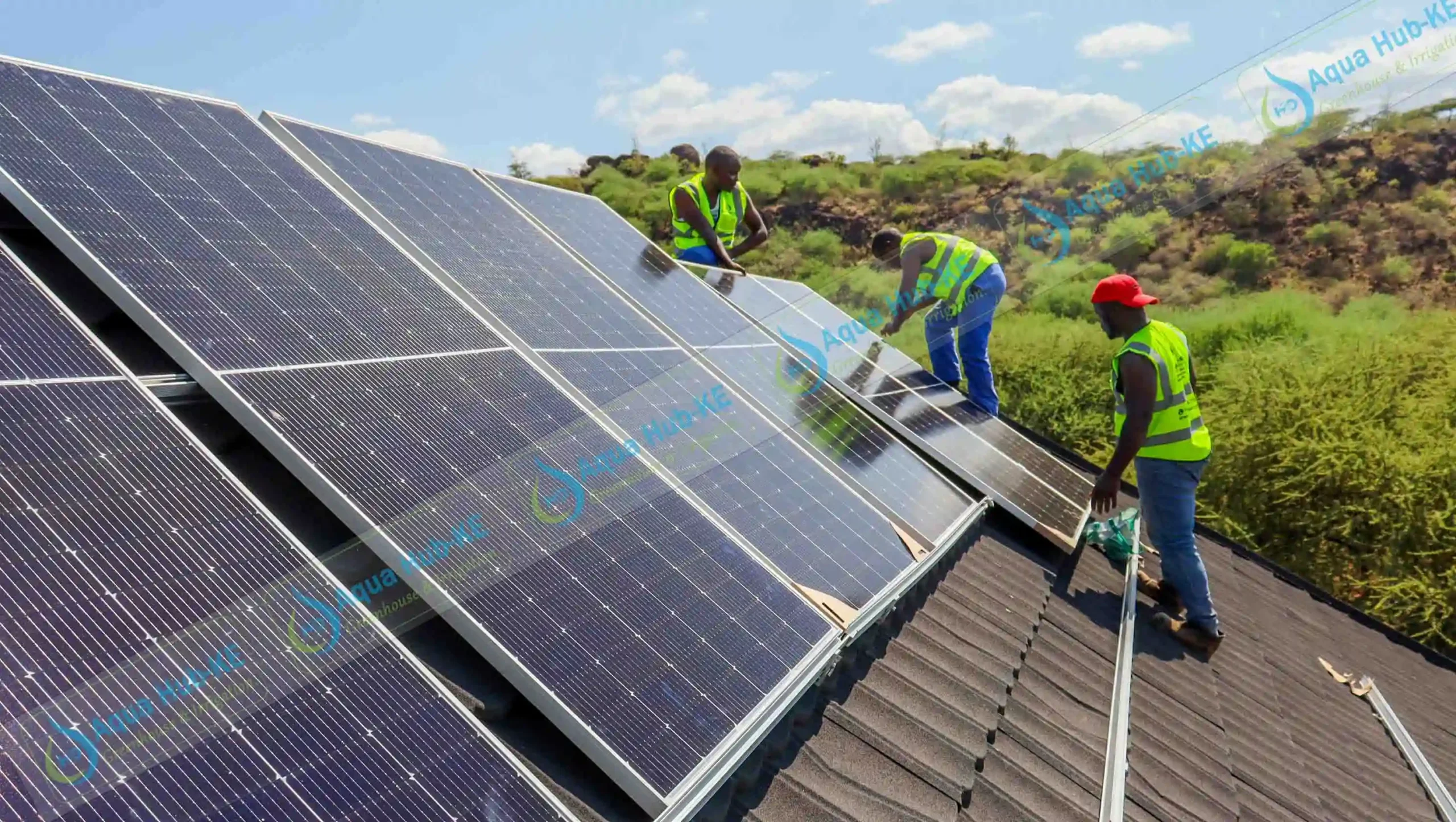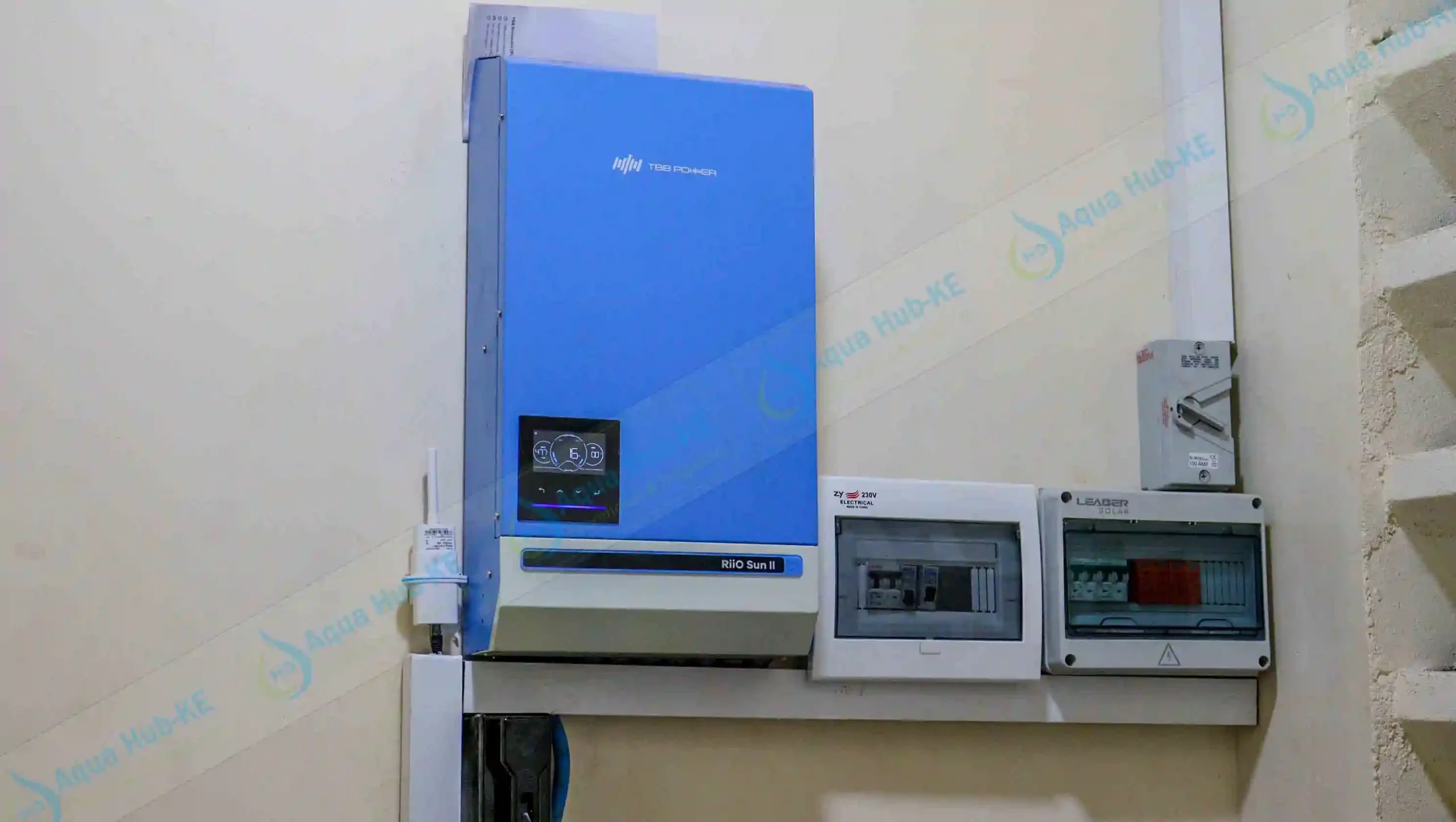Blog
5 kW Solar System Installation in Kenya

A 5 kW solar system installation is the perfect solution for homes that require high energy needs. With Aqua Hub’s solar systems, you can save much that could have been spent on Kenya power.
Go Solar today and start running on zero energy expenses.
Call 0790719020
What is a 5 kW Solar System?
A 5 kW solar power system is a setup designed to generate up to 5 kilowatts of electricity when the sun is shining at peak intensity. This capacity makes it ideal for Kenyan households with moderate to high energy consumption, typically homes with 2-4 bedrooms running multiple appliances.
How does a 5 kW solar System Operate?
The system captures sunlight through solar panels and converts it into usable electricity for your home.
An average home in Kenya uses approximately 16kWh of electricity per day. A well-designed 5kW solar system generates between 20 to 25 kWh daily, depending on your location, weather conditions, and panel positioning. This means most households can achieve near-complete energy independence with this system size, with excess power available for storage or grid export.
A 5kW system provides sufficient power to run essential appliances such as refrigerators, television, lighting, water pumps and fans. This makes them a popular residential solar power system size.
Essential Components for 5kW Solar System Installation
Solar Panels (PV Modules)

Solar panels being installed on the roof
Main component of solar power system. It harnesses sunlight power and converts it to Direct Current (DC) electricity. Monocrystalline panels are the most efficient. When buying solar panels efficiency ratings and wattage size matter. 6 – 10 panels are ideal for a KW system.
Hybrid Inverter

Inverter installed for DC to AC current conversion.
Converts DC current to AC current which is required to power most home appliances. A 5KVA hybrid inverter is required for a 5KW solar system.
Hybrid inverter enhances uninterrupted power supply due to automatic switch between solar, battery power and grid power. May also contain built-in MPPT controllers that optimize solar panel output.
Solar Batteries

backup batteries for solar power storage
Batteries are required for storage of electric current to enhance usage at night or periods with low sunlight. For a 5kw system a 5kwh lithium battery would be provide sufficient backup power.
Lithium batteries are more preferred than lead batteries but more expensive because they last longer.
Mounting Structure
Steel Mounting frames are used for holding solar panels on roofs for maximum sunlight exposure. Includes clamps, fasteners and screws.
Accessories
DC or AC cables, circuit breakers, earth wires.
You can also monitor your power consumption, input and battery status using a mobile application.
How Much Does a 5 kW Solar System Installation Cost in Kenya?
The cost of a complete 5kW solar system installation in Kenya ranges from KES 350,000 to KES 550,000 depending on component quality, battery type, and installation complexity.
5 kW Solar System Options
Budget-Friendly Option (KES 350,000 – 400,000):
- 6-8 standard efficiency solar panels
- Basic 5kVA hybrid inverter
- 5kWh lithium battery or lead-acid battery bank
- Standard mounting structure
- Basic installation and wiring
Mid-Range Option (KES 400,000 – 480,000):
- 8-10 high-efficiency monocrystalline panels (550W)
- Quality 5kVA hybrid inverter with advanced features
- 5kWh premium lithium battery
- Aluminum mounting rails with corrosion resistance
- Professional installation with monitoring system
Premium Option (KES 480,000 – 550,000+):
- 10 top-tier panels from recognized brands
- High-quality hybrid inverter
- 10kWh lithium battery for extended backup
- Heavy-duty mounting system
- Comprehensive installation with extended warranty
Breakdown of 5 kW Solar System Installation Cost
| Component | Price Range (KES) | Notes |
| Solar Panels (550W each) | 15,000 – 25,000 per panel | Need 9-10 panels for 5kW |
| 5kVA Hybrid Inverter | 45,000 – 110,000 | Quality varies significantly |
| 5kWh Lithium Battery | 80,000 – 150,000 | LiFePO4 recommended |
| Mounting Structure | 20,000 – 40,000 | Depends on roof type |
| Installation Labor | 30,000 – 50,000 | Professional installation essential |
| Accessories & Wiring | 15,000 – 30,000 | Cables, breakers, surge protection |
Factors Affecting Solar System Installation Cost
Several factors influence your final installation cost beyond basic component pricing. Roof complexity plays a significant role installation on sloped corrugated iron roofs are typically straightforward, while flat concrete roofs or multi-level buildings require additional structural work and mounting equipment.
Your location affects both transportation costs and Labor rates. Urban installations in Nairobi or Mombasa may command premium labor rates but benefit from easier equipment access. Rural installations face higher transportation costs but potentially lower labor expenses.
System design complexity also impacts pricing. Homes requiring extended cable runs, multiple battery banks, or integration with existing backup systems incur additional costs. Always request itemized quotes from multiple installers to understand exactly what you’re paying for.
Step-by-Step 5 kW Solar System Installation Process
Step 1: Initial Consultation and Energy Audit
An extensive evaluation of your energy requirements is the first step in the installation process. To calculate your typical kilowatt-hour (kWh) usage, a trained solar technician will analyze your monthly electricity consumption by looking at previous KPLC invoices. This information serves as the basis for system sizing, guaranteeing that you install a system that satisfies the needs of your home.
The number of appliances you use, peak usage periods, and any planned additions like water heaters or electric cars are all taken into consideration by the installer during the consultation. Designing a system that maximizes savings without needless oversizing that raises expenses without commensurate advantages requires an understanding of your consumption patterns.
Step 2: Site Survey and Assessment
After the first consultation, a tech team carries out a thorough site survey to check if your property is a good fit for solar installation. The technicians look at your roof’s structural soundness, its orientation, tilt angle, and any potential shading from trees or nearby buildings. In Kenya, solar panels work best on roofs that face north or northeast with little shading during the day.
The survey also looks at your current electrical setup to make sure it can work with the new solar system. If you live in an older home, you might need to upgrade your electrical panel to safely add solar power. The team will also figure out the best way to run cables between the panels and the inverter, which is usually placed indoors or in a safe outdoor spot.
A thorough site assessment leads to a detailed report that includes system layout drawings, equipment specs, and estimated energy production. This documentation is essential for providing accurate quotes and, if needed, for permit applications.
Step 3: System Design and Quotation
Based on the energy audit results and the site survey info, your installer will create a tailored solar system just for your home. This design will detail how many solar panels you need, where they’ll go, the inverter size, battery storage needs, and all the other accessories involved.
You’ll get a detailed quote that breaks down all the cost-like equipment, labor, permits, and any extra work such as roof reinforcement.
Quotation also includes performance metrics: daily energy output and time taken to break even.
Step 4: Permits and Approvals
For grid-tied systems in Kenya, you’ll need approvals from the Energy and Petroleum Regulatory Authority (EPRA) and your local county government. Your installer should guide you through this process, which involves submitting system design plans and technical specifications.
The permit process can take several weeks depending on demand and location, so plan accordingly. Off-grid solar systems typically don’t require permits, simplifying the installation timeline. Your installer should handle most paperwork but verify permit status before installation begins.
Step 5: Actual 5 kW solar system Installation
Professional solar system installation typically takes 1-3 days, depending on system size and complexity. The process involves several steps below:
Mounting System Installation
- Install mounting rails and brackets on your roof
- Ensure waterproof sealing at all penetration points
- Position rails for optimal panel placement
Panel Installation and Wiring
- Mount solar panels securely onto the racking system
- Connect panels in series/parallel strings
- Run DC cables from roof to inverter location
Inverter, Battery, and Electrical Connections
- Install inverter in designated location (indoor/outdoor)
- Connect battery bank to inverter
- Wiring system to your home’s electrical panel
- Install safety devices (breakers, surge protection, earthing)
Step 6: Testing and Commissioning
After physical installation, comprehensive testing ensures your system operates safely and efficiently. Technicians conduct polarity checks, insulation resistance tests, and performance verification to confirm all components function correctly. The inverter is programmed according to your preferences setting charging priorities, grid interaction parameters, and load management.
For grid-tied systems, Kenya Power may conduct a final inspection before authorizing grid connection. Once approved, a bi-directional meter records both your consumption from the grid and any excess power you export. Your installer demonstrates system operation, explains the monitoring interface, and provides documentation covering warranties and maintenance guidelines.
Commissioning marks the official start of your solar-powered life. You’ll immediately notice reduced reliance on grid electricity, with your system handling daytime loads entirely from solar production.
What Can a 5 kW Solar System Power?

3 bedroom apartment using a 5kW solar System
- Lighting: Up to 25 LED lights running 10-12 hours daily, more than enough for any home
- Entertainment: Multiple TVs, home theatre systems, music systems, and gaming consoles
- Kitchen: Refrigerator and freezer (continuous), microwave (intermittent use), electric kettle, blender, and coffee maker
- Laundry: Washing machine (not recommended to run multiple large appliances simultaneously)
- Security: CCTV cameras, electric fence, and Wi-Fi routers all running 24/7
- Water: Booster water pump for pressure systems
- Comfort: Iron box (intermittent), water dispenser, fans
Solar Power Management Tips
5kw Solar system is powerful but requires management of high-consumption appliances to maximize efficiency. Management tips include:
Scheduling energy intensive tasks like ironing and laundry to peak sunshine hours (11 a.m. – 3 p.m.).
Avoid running multiple high wattage appliances simultaneously. Operating a washing machine, iron box and electric kettle once may exceed the maximum output capacity, 5 KVA for 5 kW system and causes shutdown.
Types of Solar Power Systems in Kenya
Off-Grid Solar Systems
Off-grid solar systems work fully on solar power. They are ideal for remote places where grid electricity is not available. Cost more to install but cuts down electric bills. No permits needed because of no grid connection. Best for rural homes, holiday cottages and property with no access to electricity.
Grid-Tied Solar Systems
Grid-tied systems connect to grid power lines. It allows you to use grid power when solar energy is insufficient and export excess solar energy when production exceeds consumption. This configuration requires a bi-directional meter to track power flow in both directions. No large batteries are needed with this connection.
Grid-tied systems make sense for homes with predictable consumption patterns and reliable grid access. However, most standard grid-tied systems shut down during grid outages for safety reasons, meaning you lose power despite having solar panels.
Hybrid Solar Systems
Hybrid solar systems combine both grid connection and battery storage for backup power. Common for urban areas, especially for homes seeking to cut cost of grid power and solutions for frequent power outages. During outages, the system automatically switches to battery power and maintains essential load until power is back. The automatic switch does not damage your electronic gadgets.
Solar Batteries: Lithium vs. Lead-Acid
The battery used significantly impacts your solar system’s performance, longevity, and total cost of installation.
Lithium batteries are more efficient and long lasting. Can last for 10 – 15 years. It costs more than lead acid batteries but are much more durable and energy efficient.
Benefits of 5 kW Solar System Installation in Kenya
- Saves on the cost of Electricity Bills. With solar power you stop or lower the expenses of buying electricity.
- Highly Reliable: solar power doesn’t disruption compared to grid power. In periods of low sunlight, power is drawn from backup batteries.
- Environmentally safe: solar power replaces generators, cooking stoves and other devices that emit carbon.
Top Solar System Installation Company in Kenya
Aqua Hub LTD is a top dealer in solar power system installation in Kenya. We have excellent expertise in installation, sizing and sales of solar pumps, solar home power system and solar dryers.
Call 0790719020
Solar System Maintenance Requirements
- 5 kW solar system has minimal maintenance requirements and therefore operates with little attention. However, you can still monitor with the following maintenance tasks.
- Solar Panel cleaning – to remove dust and debris that could lower solar power collection.
- Visual inspections – periodically check your system for loose connection, damaged cables or faulty inverter.
Frequently Asked Questions (FAQs)
1. How much does a 5 kW solar system cost in Kenya?
A complete 5kW solar system installation in Kenya cost between KES 350,000 to KES 550,000, as per the quality and battery type.
2. What can a 5 kW solar system power in my home?
Household appliances include 25 LED lights, refrigerators, multiple TV screens, microwave, washing machine, electric kettle, water pump, routers, and CCTV cameras.
System generates 20 – 25 kWh which exceeds average 16kWh home consumption in Kenya.
3. How long does a 5 kW solar system last?
Solar panels last 25 – 30 years. Hybrid inverters and lithium batteries last 10 -15 years.
4. How long does solar panel installation take in Kenya?
1 – 3 days as per the system size. Additional term may be needed for processing permits.
5. Will my solar system work during cloudy days or at night?
Yes. It uses battery storage at night.
6. Do I need a permit to install solar panels in Kenya?
Off-grid solar power systems don’t require permits. Grid tied systems require approval from county government and EPRA.
7. How much can I save on electricity bills with a 5 kW solar system?
Savings vary based on your consumption patterns, system configuration, and how much daytime electricity you can use directly from solar production.
8. Should I choose lithium or lead-acid batteries for my solar system?
Lithium batteries are better. They are more efficient and durable than lead acid batteries.
9. How many solar panels do I need for a 5 kW system?
It depends on the capacity of the panels used. For 400 W panels you will need 17 of them.
10. How many batteries are needed for a 5 kW solar system?
4 inverter batteries of 12 V 200AH.
